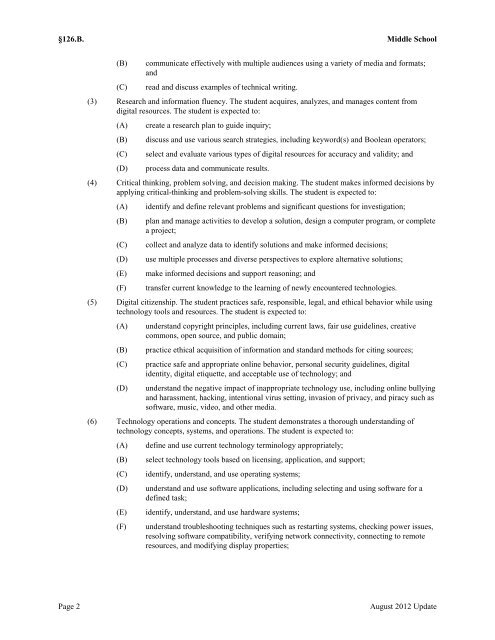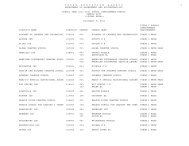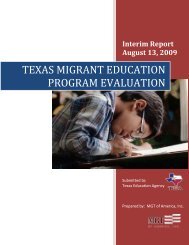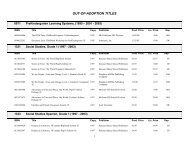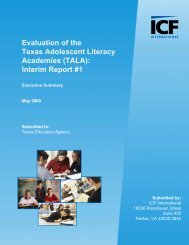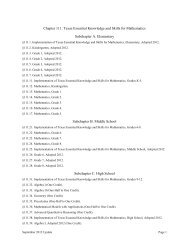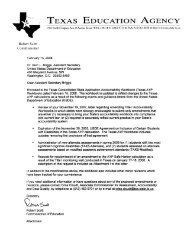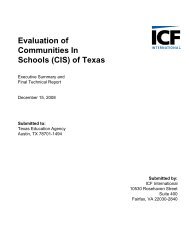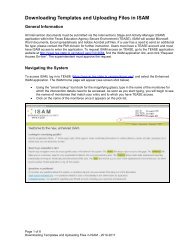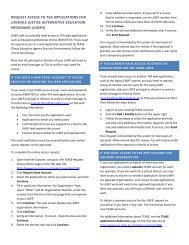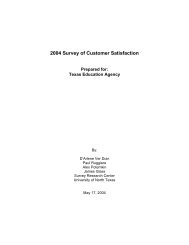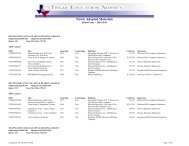Chapter 126. Texas Essential Knowledge and Skills for Technology
Chapter 126. Texas Essential Knowledge and Skills for Technology
Chapter 126. Texas Essential Knowledge and Skills for Technology
Create successful ePaper yourself
Turn your PDF publications into a flip-book with our unique Google optimized e-Paper software.
§<strong>126.</strong>B.<br />
Middle School<br />
(B)<br />
(C)<br />
communicate effectively with multiple audiences using a variety of media <strong>and</strong> <strong>for</strong>mats;<br />
<strong>and</strong><br />
read <strong>and</strong> discuss examples of technical writing.<br />
(3) Research <strong>and</strong> in<strong>for</strong>mation fluency. The student acquires, analyzes, <strong>and</strong> manages content from<br />
digital resources. The student is expected to:<br />
(A)<br />
(B)<br />
(C)<br />
(D)<br />
create a research plan to guide inquiry;<br />
discuss <strong>and</strong> use various search strategies, including keyword(s) <strong>and</strong> Boolean operators;<br />
select <strong>and</strong> evaluate various types of digital resources <strong>for</strong> accuracy <strong>and</strong> validity; <strong>and</strong><br />
process data <strong>and</strong> communicate results.<br />
(4) Critical thinking, problem solving, <strong>and</strong> decision making. The student makes in<strong>for</strong>med decisions by<br />
applying critical-thinking <strong>and</strong> problem-solving skills. The student is expected to:<br />
(A)<br />
(B)<br />
(C)<br />
(D)<br />
(E)<br />
(F)<br />
identify <strong>and</strong> define relevant problems <strong>and</strong> significant questions <strong>for</strong> investigation;<br />
plan <strong>and</strong> manage activities to develop a solution, design a computer program, or complete<br />
a project;<br />
collect <strong>and</strong> analyze data to identify solutions <strong>and</strong> make in<strong>for</strong>med decisions;<br />
use multiple processes <strong>and</strong> diverse perspectives to explore alternative solutions;<br />
make in<strong>for</strong>med decisions <strong>and</strong> support reasoning; <strong>and</strong><br />
transfer current knowledge to the learning of newly encountered technologies.<br />
(5) Digital citizenship. The student practices safe, responsible, legal, <strong>and</strong> ethical behavior while using<br />
technology tools <strong>and</strong> resources. The student is expected to:<br />
(A)<br />
(B)<br />
(C)<br />
(D)<br />
underst<strong>and</strong> copyright principles, including current laws, fair use guidelines, creative<br />
commons, open source, <strong>and</strong> public domain;<br />
practice ethical acquisition of in<strong>for</strong>mation <strong>and</strong> st<strong>and</strong>ard methods <strong>for</strong> citing sources;<br />
practice safe <strong>and</strong> appropriate online behavior, personal security guidelines, digital<br />
identity, digital etiquette, <strong>and</strong> acceptable use of technology; <strong>and</strong><br />
underst<strong>and</strong> the negative impact of inappropriate technology use, including online bullying<br />
<strong>and</strong> harassment, hacking, intentional virus setting, invasion of privacy, <strong>and</strong> piracy such as<br />
software, music, video, <strong>and</strong> other media.<br />
(6) <strong>Technology</strong> operations <strong>and</strong> concepts. The student demonstrates a thorough underst<strong>and</strong>ing of<br />
technology concepts, systems, <strong>and</strong> operations. The student is expected to:<br />
(A)<br />
(B)<br />
(C)<br />
(D)<br />
(E)<br />
(F)<br />
define <strong>and</strong> use current technology terminology appropriately;<br />
select technology tools based on licensing, application, <strong>and</strong> support;<br />
identify, underst<strong>and</strong>, <strong>and</strong> use operating systems;<br />
underst<strong>and</strong> <strong>and</strong> use software applications, including selecting <strong>and</strong> using software <strong>for</strong> a<br />
defined task;<br />
identify, underst<strong>and</strong>, <strong>and</strong> use hardware systems;<br />
underst<strong>and</strong> troubleshooting techniques such as restarting systems, checking power issues,<br />
resolving software compatibility, verifying network connectivity, connecting to remote<br />
resources, <strong>and</strong> modifying display properties;<br />
Page 2<br />
August 2012 Update


